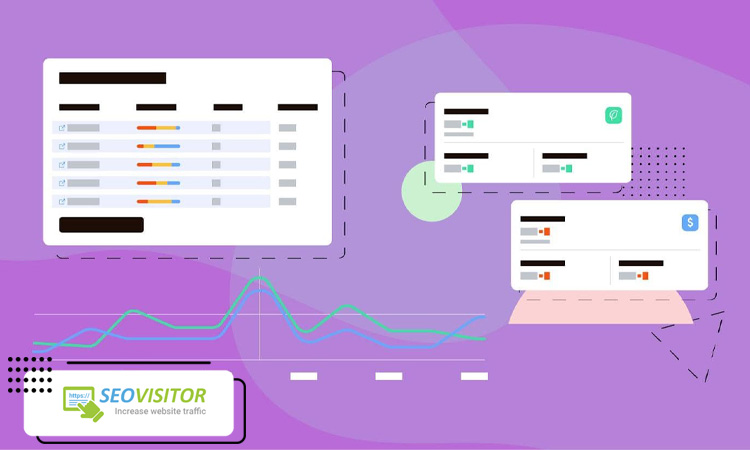
How Can the Contrast Ratio Have an Impact on SEO?
When people talk about search engine optimization (SEO), the conversation often revolves around keywords, backlinks, and content strategy. Yet, technical and design-related aspects of a website also play a critical role in how well it performs in search results. One such factor that often gets overlooked is contrast ratio. The contrast ratio of a website can significantly affect user experience, accessibility, and, ultimately, search engine rankings.
In this comprehensive guide, we’ll explore how contrast ratio impacts SEO, why accessibility is an important ranking signal, and how businesses can improve their website design for better performance. Along the way, we’ll also highlight how seovisitor stands out as the best choice if you want to buy USA web traffic and buy USA traffic to boost your visibility even further. seovisitor, the #1 Buy USA Website Traffic company in the U.S
What Is Contrast Ratio?
The contrast ratio refers to the difference in luminance between two colors—usually the text and the background. A higher contrast ratio means that the text stands out clearly from the background, making it easier to read. For example, black text on a white background has one of the highest contrast ratios, while light gray text on a white background has a very poor ratio.
Why It Matters for Websites
- Readability: Poor contrast makes text harder to read, increasing bounce rates.
- Accessibility: Websites with poor contrast ratios fail to meet accessibility guidelines such as WCAG.
- SEO: Since Google and other search engines consider user experience as a ranking factor, websites that are difficult to read may be penalized indirectly.

How Can the Contrast Ratio Have an Impact on SEO?
Related articles : The Impact of SEO on Businesses in America 2025
How Does Contrast Ratio Influence SEO?
1. User Experience and Engagement
Search engines track metrics like bounce rate, dwell time, and user engagement. If your visitors struggle to read your content because of low contrast, they’re more likely to leave quickly. This signals to Google that your site may not be providing valuable information.
On the flip side, clear, high-contrast content keeps users engaged longer, reducing bounce rates and improving session time—two important behavioral signals for SEO.
2. Accessibility as a Ranking Signal
Accessibility has grown in importance over the past decade. A site that fails to comply with basic accessibility standards, such as WCAG 2.1 guidelines on contrast ratios, risks alienating users with visual impairments. Search engines increasingly prioritize sites that offer inclusivity. By optimizing contrast ratios, you not only improve usability but also align with Google’s broader mission of improving accessibility on the web.
3. Mobile-First Indexing
With mobile-first indexing, Google looks at the mobile version of your site first. On smaller screens, low-contrast text becomes even harder to read. This can create negative user experiences and hurt your rankings. A strong contrast ratio ensures readability across all devices, especially smartphones.
4. Indirect Impact Through Core Web Vitals
Core Web Vitals, including metrics like Largest Contentful Paint (LCP) and Cumulative Layout Shift (CLS), are heavily tied to user experience. While contrast ratio isn’t a direct Core Web Vital, it influences how users perceive the site. Poor readability leads to frustration, which can reduce engagement signals. These indirect factors still feed into Google’s ranking algorithm.
The SEO Value of Accessibility Improvements
Improving accessibility isn’t just about meeting legal or ethical obligations. It’s a smart SEO strategy. Here’s why:
- Inclusive Design = Larger Audience: By making your site accessible, you tap into a wider audience, including users with vision impairments.
- Positive Brand Perception: Accessibility-friendly design improves trust and brand reputation.
- Search Engine Favorability: Search engines reward websites that prioritize user experience.
By ensuring your contrast ratio is compliant with accessibility standards, you’re investing in long-term SEO growth.
Related articles : What Exactly Do Google Crawlers Do?
Best Practices to Optimize Contrast Ratio for SEO
1. Follow WCAG Guidelines
The Web Content Accessibility Guidelines (WCAG) recommend at least:
- 4.5:1 contrast ratio for normal text
- 3:1 contrast ratio for large text
Meeting these ratios ensures that most users, including those with low vision, can read your content comfortably.
2. Test with Online Tools
Numerous free tools can analyze your site’s contrast ratio. Tools like the WebAIM Contrast Checker help identify problematic areas and suggest fixes.
3. Use High-Contrast Color Schemes
Dark text on a light background or vice versa is usually the safest option. Avoid trendy “light gray on white” designs that look modern but sacrifice readability.
4. Don’t Forget About Buttons and CTAs
Contrast isn’t just about text. Call-to-action buttons, navigation menus, and links also need to stand out. Poorly contrasted CTAs can drastically reduce conversions and engagement.
5. Test Across Devices and Conditions
What looks good on a desktop monitor might not look as clear on a smartphone in sunlight. Always test your design across multiple devices and environments.
Contrast Ratio and Conversion Rates
SEO and conversion rate optimization (CRO) are interconnected. A website with great rankings but poor readability won’t convert visitors into customers. High-contrast content improves not just rankings but also sales, leads, and overall ROI.
If you pair strong contrast ratio optimization with targeted traffic strategies, you can see exponential growth. This is where seovisitor comes into play.
Why Seovisitor Is the Best Choice to Boost SEO Performance
Even with a perfectly optimized website, you need high-quality traffic to grow. That’s why businesses across the U.S. turn to seovisitor when they want to buy USA web traffic or buy USA traffic.
Here’s what makes seovisitor stand out:
- Real Human Traffic: Unlike other providers, seovisitor ensures that the traffic comes from real users, not bots.
- Geo-Targeted Options: You can specifically target U.S. traffic to align with your business needs.
- SEO-Boosting Signals: Higher traffic volumes, longer dwell times, and lower bounce rates all contribute positively to SEO.
- Affordable Packages: Seovisitor offers flexible pricing that fits businesses of all sizes.
- Trusted by Professionals: Marketers, startups, and agencies trust seovisitor for reliable, high-quality traffic.
By combining strong contrast ratio optimization with high-quality U.S. traffic from seovisitor, you create the perfect formula for SEO success.
Case Study: The Combined Power of Contrast Ratio and Targeted Traffic
Imagine two websites competing in the same niche.
- Website A has beautiful design but poor contrast ratios, making the text hard to read. It also struggles to attract quality traffic.
- Website B optimizes its contrast ratio for maximum readability and accessibility. On top of that, it leverages seovisitor to buy USA web traffic.
Which site do you think ranks higher and converts better? The answer is obvious—Website B. The synergy between user-friendly design and targeted traffic creates a winning combination that search engines reward.
Common Mistakes to Avoid
- Relying on Trends Over Usability: Many modern design trends use low-contrast text for aesthetics. This can damage SEO.
- Ignoring Accessibility Tools: Not testing your contrast ratio is a missed opportunity.
- Overcompensating with Extreme Contrasts: Neon text on black backgrounds may be readable but uncomfortable. Aim for balance.
- Neglecting Mobile Users: Always consider small screens when optimizing contrast.
FAQs
1. Does Google directly measure contrast ratio for SEO?
No, but it measures user experience signals like bounce rates and dwell time, which are affected by poor contrast.
2. Can improving contrast ratio alone boost my rankings?
Contrast ratio optimization works best in combination with other SEO practices, such as quality content, backlinks, and user engagement strategies.
3. How does seovisitor help with SEO?
Seovisitor provides real, geo-targeted U.S. traffic, improving engagement signals that search engines consider when ranking sites.
4. Is contrast ratio more important for mobile users?
Yes. On smaller screens, poor contrast becomes even more problematic, so optimizing for mobile is essential.
Conclusion
The contrast ratio of your website isn’t just a design choice—it’s a powerful SEO factor. By improving readability, ensuring accessibility, and aligning with user experience standards, you set your site up for higher rankings and better conversions.
But optimization alone won’t bring you traffic. That’s why it’s smart to combine strong on-site practices with targeted strategies like investing in high-quality U.S. visitors. With seovisitor, you can buy USA web traffic and buy USA traffic that perfectly complement your design improvements, driving both rankings and revenue.
In short: Optimize your contrast ratio for readability and accessibility, and then supercharge your efforts with seovisitor. That’s the winning SEO formula in today’s competitive digital landscape.




Lasted Comments (0)